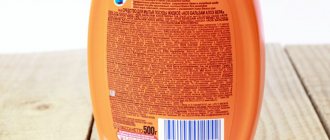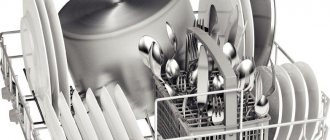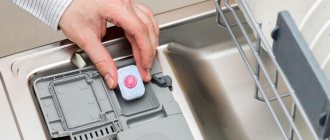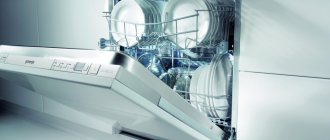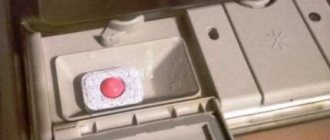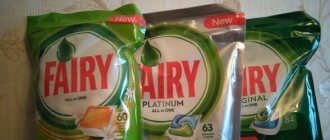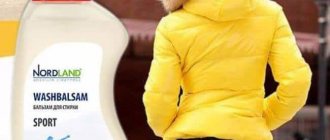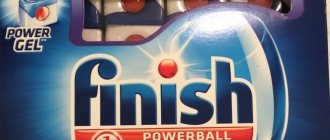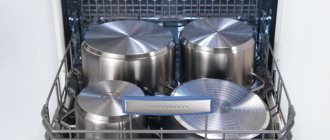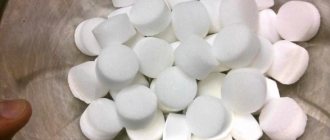People buy a dishwasher to save time and effort. When choosing equipment, housewives dream that she will take care of the plates and pots herself. You just need to put them in the car, press a button, wait, and then just enjoy the squeaky clean utensils.
All this is possible only if you choose the right household chemicals. We will tell you which dishwasher detergent is best. We'll show you how to find the optimal composition that effectively washes dishes and leaves no traces.
Choosing detergents for the car
First, let's look at the issue of choosing detergents, because they can both ruin and significantly improve the operation of the PMM. There is a whole group of detergents that are needed at different times, for different purposes and in different doses.
Here is the list:
Salt - allows you to soften hard water, dissolve calcium, thereby preventing the inside of the machine itself and the dishes from being covered with limescale. How often.
Before purchasing various household appliances, you should read the instructions for their use, especially if these appliances are expensive. Any accidental breakdown can cost us a lot if we haven’t done it first. In particular, if it is a dishwasher that has recently entered our everyday life. The first dishwashers appeared at the end of the 19th century, and since then they have made the work of housewives much easier. This miracle technology has become an integral, very convenient part of the household. What needs to be taken into account when using the unit, following the instructions for dishwashers?
We evaluate environmental friendliness
Protection of nature and safety for health have been the main trend in dishwashers for the last 5-7 years. There are more and more products labeled ECO, and their prices are 20-50% higher than regular brands. So is it worth overpaying?
The issue of environmental friendliness more often arises when there are small children in the house. A caring mother can be understood - she does not want the child to be poisoned by anything. Or if a family member is allergic, and any fragrances affect him negatively. In such cases, the family budget suffers - you have to buy expensive bio-pills.
But are these fears justified? Modern dishwashing detergents from well-known brands are harmless to health, otherwise they would be banned from sale. Most manufacturers have moved away from the use of phosphates and chlorine, and began to include nonionic and less often anionic surfactants in their composition.
However, even if there are phosphates among the components, you should not worry about safety. Their concentration in relation to other ingredients is carefully verified, so during a standard washing cycle the substance has time to both clean the dishes and be completely washed off the surfaces.
This was confirmed by Roskontrol experts, who in 2016 tested the cleaning quality and washability of several brands of tablets and powders. If the product is used for its intended purpose in accordance with the instructions and in a suitable program, there is no risk to health. The residual amount of the substance in washes from treated surfaces is insignificant and meets the standards with a large margin.
Types of dishwasher detergents – tablets, powders or gels?
In order for the “dishwasher” to serve faithfully for many years, and for the dishes to sparkle and squeak with cleanliness after it, you need to choose suitable and effective detergents.
What does the modern market offer?
Economical, popular and convenient type of detergent. Disadvantages: you can pour it past the compartment or even, in special cases, scratch the dishes. Accidentally inhaling microparticles of powder when pouring is also not beneficial. The washing cycle “eats” about 30 g.
What are the requirements for dishwasher detergents?
Dishwasher detergents have special requirements because they differ from hand-washing detergents. The fact is that hand-washing products foam a lot, and if you put them in a dishwasher, you can easily break the device.
Based on this, dishwasher detergents should:
- Do not foam much;
- Do not have a corrosive effect (corrode PMM elements);
- Easy to wash off. Dishwashers are designed in such a way that they save you water; To wash away dirt and detergent from the dishes, a certain portion of water is released. If the product is not easily washed off, then some of the product will remain on the plates after washing;
- Possess high quality washing. It is necessary that the product used can clean even the most difficult stains. In this case, the drug should not be toxic or aggressive.
Expert opinion
Vyacheslav Budaev
Dishwasher expert, repairman
If the product used does not meet the above requirements, the quality of washing will be poor and there will be a risk of damage to the dishwasher.
Rating of funds for PMM
To make your choice easier, we reviewed popular dishwashing powders and also found out user reviews. Which brand should you prefer?
Finish
It is recommended to take it when buying a car. Active advertising affects many buyers; they find Finish effective and economical. The bottle holds 2.5 kg and has a convenient dispenser.
The manufacturer promises:
- Removing burnt fat.
- The included StainSoaker component copes with dried flakes and porridges without soaking.
- Removing stains from tea and coffee, lipstick marks.
- The shine and shine of glass.
- Can be used for plastic, ceramic, metal dishes.
The cost of a 2.5 kg bottle is from 600 rubles.
Daria
I decided to change the detergent and try the famous “Finish”. I immediately decided on tablets, but my attention was attracted by a huge canister of powder, and at a discount. Having brought the bottle home, I discovered a convenient spout for falling asleep:
The first wash was unsuccessful, all the dishes were soapy, the product did not wash well. The next time I started a long cycle and lowered the dosage. I was pleased with the result, but I noticed that Finish is aggressive with the designs on the dishes, leaving scratches.
Having read the contents on the label, I was not happy: bleach, phosphonates, surfactants. But these are household chemicals. The consumption is economical: a 2.5 kg canister is enough for 4 months of use.
There is an alternative to the usual “Finish” - this is an environmentally friendly product made in Japan, Finish Powder. Its price is from 600 rubles per 800 g. Does not contain phosphates.
Somat
Inexpensive Somat powder, according to users, is less effective. However, the manufacturer claims that the product removes complex and dried stains. The effect of soda prevents stains and plaque, provides shine and shine to devices. It washes out well.
Ingredients: bleach, phosphonates (15-30%, which is several times higher than the norm), surfactants, enzymes.
The price of a 2.5 kg bottle is from 500 rubles.
Olga
I was attracted by the bright Somat bottle and ergonomic handle. I tried Finish before, but it is expensive, and Somat is cheaper, especially on sale. The bottle dispenser is very convenient, you definitely won’t miss it:
The packaging says it lasts for 83 washes, but mine lasted longer. For example, shorter cycles require less dosage. I was pleased with the result; the dishes washed well, without streaks.
An important point is the absence of odor after washing. I believe that plates should not smell like a freshener. From now on I will always use Somat.
Claro
Product made in Austria. Can be used in any dishwasher, provides a triple blow to dirt:
- Green granules deal with stubborn and dried food residues.
- White ones contain active oxygen and provide cleaning.
- Blue ones prevent the settling of limescale.
The composition, despite the place of production, is very similar to the previous version: phosphonates from 15 to 30%, bleach, polycarboxylate 5%.
A 2.5 kg package costs from 600 rubles.
Nastya
When buying a dishwasher, the seller advised to buy 3-in-1 tablets. I tried it, but in the end I stopped taking it because the price was too high. A friend at work advised me to try Claro. I can say that Claro is very economical in consumption. There is a measuring spoon:
With my compact model (6 sets) it was enough for 200 washes! I install only standard long-term programs, it washes well. Only on glass utensils do stains appear. But after adding rinse aid, the dishes sparkle. I'm satisfied and will buy it.
Paclan Brileo
"Paklan Brileo" produced in Belgium contains enzymes that allow you to cope with heavy plaque. Contains amylase - helps to wash potatoes and porridge, protease - breaks down protein products.
The cost of a 2.5 kg package is from 400 rubles.
Marina
Initially I wanted to buy Finish, but I mixed up the bottles (they are similar) and took Paklan. I had to use it. Surprisingly, the result was excellent. The most problematic items were washed. Here is the porridge ladle:
The jar itself has a comfortable handle and a folding spout for dispensing:
I was pleased that the contents were odorless. I fill the compartment full, and 1 kg lasted me for three months. Mega-economical! In addition, it is much cheaper than many popular brands.
YPLON
Has an antibacterial effect. Removes carbon deposits, vegetable and animal fats. Can be used for automatic dishwashers. Gives devices shine and shine.
A 3 kg bottle costs from 900 rubles.
Alina
I was amused by the packaging, which is twice the size of the contents. In general, Yplon does its job well. Even washes pots after burnt porridge. Three kilograms is enough for six months of use with daily loading. Be sure to add rinse aid, otherwise streaks will remain on the glass. Cheap and cheerful.
Zool
Concentrated composition made in Germany. Does not contain chlorine, can be used for silver in a delicate program. Contains enzymes to eliminate protein particles and dried food debris. Hypoallergenic.
Price - from 300 rubles per 750 g.
Lesya
My new dishwasher purchase is Zool. The granules look as usual: white and blue. The cardboard packaging does not have a dispenser, so pouring is inconvenient. In general, the devices were cleaned well. I also use salt and rinse aid, the combined effect leads to a positive result.
Sodasan and Ecover
They are environmentally friendly products that do not contain phosphates. The action is identical, the components are slightly different:
- "Sodasan" contains 15-30% silicates, 5-15% sodium percabonate, 5% surfactant, alcohol sulfate.
- "Ecover": oxygen bleach 15-30%, surfactant 5%, enzymes, sodium citrate, sorbitol.
For a pack of Sodasan 2 kg you will have to pay from 1000 rubles, for Ecover 1.36 kg - from 800 rubles.
Users note the environmentally friendly composition of Sodasan and Ecover, but complain that they do not cope well with persistent stains. A white residue remains on the surface of plates and spoons, which disappears when using rinse aid.
Lotta 6-in-1
The concentrate performs six functions simultaneously:
- washes;
- rinses;
- protects against corrosion;
- adds shine;
- protects against scale (contains salt);
- breaks down proteins (using enzymes).
The packaging says that Lotta powder is created on a mineral and plant basis. And yet the incoming compounds are not encouraging: phosphates, phosphonates, bleaches, surfactants and other additives.
The cost of the Italian product is 1.2 kg - from 200 rubles.
Karina
This is my first time using Lotta; during the crisis, the price was right. It is not very convenient to fill the contents, since the packaging is cardboard and opens from the side:
A large dose is often released. In general, it lasts for 60 cycles. I often run it without rinse aid, but always with salt, since the water in the region is hard. The plates are always clean, there is no smell from the chamber. An excellent replacement for pills if you don't have enough money.
Top House
The formula with active oxygen copes with heavy deposits, protects glass products, giving them shine, and prevents the appearance of scale. With antibacterial effect.
A 1 kg bottle will cost 400 rubles.
Tamara
Top House, although a little expensive, is used economically. Cleans devices well, no residue remains. The only upsetting thing is the abundance of “chemistry”: more than 30% phosphates. This is more than other manufacturers. It comes in a convenient package with a handle, although there is no dispenser, so it’s hard to navigate the volume. The lid is childproof, which is especially important for me.
Five Plus
Similar in composition to Top House, only slightly less phosphates - 15%. Suitable for cleaning pots, pans and other utensils.
Price for 1250 g - from 200 rubles.
Alyona
Five Plus has become my favorite tool. It even washed away burnt areas that Finish couldn’t handle, and the price was lower. Even the bottles are similar in appearance, probably the manufacturer wanted “5+” to be associated with Finish. But now I will only buy Five Plus.
KAO Citric Acid Effect
Powder made in Japan. Effectively breaks down dirt, preventing it from settling on the surface. Not suitable for fragile products. Available in a small plastic box with a volume of 680 g. The cost is high - from 800 rubles.
Svetlana
I have respect for Japanese products, so I bought Citric Acid Effect (KAO). Of course, I was confused by the high price for only 680 g, but I already know that the Japanese offer only good products.
The components were also pleasing: only 3% surfactant, carbonate, water softener - nothing dangerous. A spoon is included with the tray.
It is used very economically. It does not remove severe burns, but softens them so much that they can be easily removed with a brush. Glassware sparkles with cleanliness. The CAO was enough for 113 cycles.
Photo 29
Amway
This concentrate contains double enzymes, so it penetrates deeply and breaks down various contaminants. Contains 5% surfactants, 5-15% oxygen bleach, polycaboxylates.
Cost 1.4 kg - from 800 rubles.
Yana
Overall I liked Amway, but the packaging was terrible. If you take it with wet hands, it will immediately get wet. I have to pour it over. Use as directed on the packaging. The photo shows an excellent result.
Available domestically produced powders
Having noticed a cheap product on a store shelf, and even made in Russia, most buyers bypass it and choose foreign brands. Is this attitude fair? Let's consider domestic powders. Let's start with the cheapest and move on to the most expensive:
- Rail . Contains biological enzymes and active components. Copes with the functions of a detergent, rinse aid, and protects against scale. A pack of 600 g costs from 90 rubles. Consumers were satisfied with the quality of the wash.
- Tyron . Standard chemical composition, polyethylene pack. For 1 kg you will pay from 90 rubles. Using and filling Tyron is inconvenient, but the result pleased users:
- Sanit. Removes fatty and protein residues, tea stains. Deals with dried food, disinfects and eliminates unpleasant odors. The price of a 1 kg pack is from 120 rubles. Judging by the reviews, it copes with carbon deposits and does not leave a white residue.
- "Cinderella". Reviews convince us that “Cinderella” copes with pollution with a “C”. You have to fill the entire compartment, so you won’t be able to save money. It is noted that the phosphate content here is lower (5-15%) than other brands. A pack of 1000 g - from 100 rubles.
- “Eonit” is praised by users and recommended for purchase. The cardboard box contains a measuring spoon that is convenient for dispensing granules. For 1.3 kg you need to pay from 300 rubles.
How to replace household chemicals? The best way is homemade powder. You can read how to make it in the publication “Do-It-Yourself Dishwasher Products.” What does this give you:
- Savings. The cost of ingredients is low.
- Environmental friendliness. Mainly soda, peroxide, and citric acid are used. No chemical additives.
It is important to use homemade products correctly, otherwise you may harm the dishwasher. Of course, this option is not as effective as store-bought products.
There is no need to pour washing powder into the dishwasher, as some users advise. This could end badly for your dishes.
Which composition is better - environmentally friendly or chemical - is up to you to decide. Everywhere there are advantages and disadvantages: for example, reduced efficiency, but safety for health and the environment. The choice is yours.
Loading dishes correctly
Now that we've sorted out the means, let's start loading. Poor washing is in 85% of cases a sign that the dishes were put in incorrectly, and not at all a signal of problems with the dishwasher.
How to load dishes correctly?
- We clean the dishes from food residues;
- We fold the dishes tightly and compactly, but so that they do not interfere with the rotation of the sprinkler arms, the opening of the dispenser, and the free passage and drainage of water. In many PMMs, sections can be rearranged to accommodate vases and baking trays;
- Pour in the powder or add a tablet; if necessary, add rinse aid and salt;
- Select the appropriate program and launch it. If you forgot to put something in, you can open the door and add the dishes, the machine will resume operation in a few seconds.
- Glasses and fragile glassware are placed at the top. It is important that it does not touch the walls. But the dishes with the most contamination are placed downwards, because this is where the strongest water jets are;
- The correct thing to do is to load the dishwasher completely, and only then turn it on;
- You can place a small batch of dishes after dinner in the tray and close the lid - this way the utensils will not dry out while waiting for the next batch. Better yet, select the half-load mode;
- The dirtiest surfaces should face down, so bowls, pans, etc. are turned upside down.
- And for small utensils such as knives and spoons, there are special trays that need to be used. It is better to alternate forks and spoons, and place the knife with the blades facing up. Only after you have correctly positioned the dishes can you turn on the machine.
Do not forget that the equipment washes dishes with hot water, so it is not allowed to place in it:
- Appliances with steel elements that may rust;
- Dishes with inserts of wood, mother-of-pearl, tin or copper elements;
- Cups with patterns or coatings that are not thermally durable;
- Glued items;
- Antique dishes;
- Plastic elements that do not have the appropriate approval markings;
- Sponges and kitchen towels;
- Crystal can be washed, but be careful, as it may become cloudy over time.
What products are needed in the dishwasher?
Have you bought a dishwasher and don’t know what dishwashing products you need?
Decided to do away with manual dishwashing and bought a dishwasher? Have you already read the instructions? If not, we recommend doing so. Now, let's talk about car products.
Moreover, you will have to figure out the products that you will put or pour into the machine so that it serves you effectively for as long as possible, and the dishes washed in it are not damaged after washing.
Therefore, let’s look at the very same dishwasher detergents that are used to effectively wash dishes.
What product do you use?
TabletsPowder
Types of dishwasher detergents
There are many different cleaning products available for dishwashers. They all have their advantages and disadvantages.
Some are designed for washing, others for rinsing. There are two formats: detergents (for example, dishwasher tablets) and additives (rinse aid, salt, deodorant, cleaner).
Dishwasher detergent should remove effectively.
Expert opinion
Vyacheslav Budaev
Dishwasher expert, repairman
As I imagine, for a dishwasher it doesn’t matter whether the product is liquid or powder, the main thing is that it is intended specifically for household, let me emphasize – household dishwashers. It’s even better if this particular brand is recommended by the manufacturer.
Any detergent is dissolved in water, after which it is used to wash dishes. Therefore, if the instructions do not directly prohibit the use of liquid detergents, I believe their use is acceptable.
Why do tablets often not dissolve?
Why tablets do not dissolve
This is the most common problem among PMM owners. But the quality of the tablets is not always to blame. Most often the reasons lie in the following:
- ignoring operating rules;
- blocking the compartment with dishes;
- discrepancy between the temperature conditions of the machine and those shown in the instructions for using the tablets;
- incorrect installation of the briquette;
- expired detergent;
- damp tablets;
- insoluble shell, which was forgotten to be removed before installation in the compartment;
- compartment clogging;
- insufficient water pressure.
Advantages and disadvantages
Liquid detergents cannot be called an analogue of powder; they may be similar in composition, but not identical. Unlike powder products, liquid products do not contain abrasive particles or other components that dissolve slowly. According to this criterion, they are better even compared to tablets. But this is not their only advantage; we list a few more advantages:
- act gently on the dishes without scratching them;
- convenient use and dosing, and therefore economical consumption;
- dissolve quickly, which is especially important if you choose short washing cycles;
- simply stored in hermetically sealed plastic packaging;
- do not emit volatile chemicals.
Only capsules can compete with liquid detergents, because they contain a gel, only already dosed.
Expert opinion
Vyacheslav Budaev
Dishwasher expert, repairman
By the way, liquid dishwasher detergent is best for pre-soaking.
How to use
Liquid dishwasher detergent is very easy to use. Usually no one has problems with this. However, some users who have been “familiar with dishwashers for a long time” and have been using liquid detergents for many years know some tricks that help them further improve the quality of washing dishes. First, let's look at the general procedure for using liquid products, and then we'll reveal a couple of secrets.
- We take the package with the liquid dishwasher detergent we like and carefully read what is written on it.
- We open the package with the product, and then open the dishwasher door.
- We find a dispenser in which detergents are placed. The dispenser has a compartment that closes with a valve; open the valve.
- Pour the liquid product into the compartment up to the mark, taking into account the instructions that came with this product and close the valve.
- Then, as usual, we place the dishes and cutlery in the baskets, push the baskets in and close the machine door.
- All that remains is to start the washing process by selecting the program you like.
In general, after this you can go about your business, watch TV or immerse yourself in a social network, the dishwasher will do everything itself, and the result will be incredibly dazzling. Now let's talk about the promised secrets of using liquid products.
Experienced housewives have long noticed that any liquid product is more active than powder or dishwasher tablets. There is no point in putting it down according to the norm, since in this case most of the active chemicals are washed down the drain. It has been experimentally proven that liquid product should be poured into the dishwasher cuvette 1/3 less than the amount stated in the instructions. In this case, the result will be exactly the same. The second secret is related to the distribution of liquid detergent inside the dishwasher.
Expert opinion
Vyacheslav Budaev
Dishwasher expert, repairman
It has been noticed that if a small amount of the product is applied to the baskets in which the dishes will then be placed, a thicker foam is formed during washing, which has a more active effect on dirt and helps to wash it 10% better.
We cannot confirm or refute the above statements of experienced dishwasher users, but if such opinions exist, they probably have a right to exist. Conduct the experiments yourself, and perhaps you will soon start sharing your tricks with social network users.
Basic composition: options are possible here
The purpose of the detergent follows logically from its name.
Dish cleaner can be available in powder, gel or tablet form. In any case, the composition contains surfactants to effectively remove contaminants (due to them, airy foam is formed), and the powders are also additionally enriched with acids. The concentration of alkalis can be both high and low: more powerful and “chemical” agents are used in the fight against stubborn fats and protein deposits, while weakly alkaline ones are distinguished by a differentiated approach - their own type of enzymes is selected for different situations.
It should be remembered that the choice of cleaner largely depends on the material of the dishes - for example, compositions based on chlor-alkali compounds are absolutely not suitable for silverware and crystal. The combination of alkalis and oxygen additives is considered a “economical”, almost universal option (however, keep in mind that the latter have a bleaching property), but soft enzymes look the best: by the way, they act even at relatively low temperatures.
In terms of economy, the bulk substance wins, but complaints are often made about the quality of its work, largely because, due to its abrasiveness, powders can significantly spoil the appearance of the dishes. Liquid compounds dissolve much easier and faster, respectively, providing a decent washing result. They do not lead to oxidation, do not affect the structure of materials in any way, and, importantly, are suitable for use in pre-soaking mode.
The presence of salt, which is occasionally mixed into the gel, does not negate the use of the main regeneration product - such an additive will clearly not be enough to correct the structure of the water and fully protect the device.
Gels intended for hand washing dishes are strictly taboo: they create excessively lush foam and can easily cause leaks.
As for tablets, the attitude towards them is very contradictory. On the one hand, this is very convenient - the compressed substance does not crumble and is stored extremely compactly. At the same time, one cannot turn a blind eye to certain shortcomings: if you set a short program, the tablet or capsule will not have time to completely dissolve, which is not only impractical, but also quite expensive - the cost of such products sometimes goes through the roof.
Before testing the tablets (they are added one per cycle), you need to make sure that the model of equipment you are using in principle allows such a measure - “experienced” dishwashers may not recognize a foreign object. And finally, the third point: each type of washing “pills” is tailored to a certain level of water hardness, that is, it is likely that you will have to work hard to artificially reduce it.
Some users, puzzled by finding a budget replacement for tablets, come to an ambiguous solution: they prepare home remedies based on washing powder. In terms of environmental friendliness, they are highly questionable, so it would be better to try other combinations.
TOP 7 best dishwasher detergents
Below are popular brands of detergents for use in the dishwasher:
- Fairy Platinum All in 1;
- BioMio Bio-total;
- Clean & Fresh All in 1;
- Somat Standard;
- Synergic;
- Finish Quantum;
- Eared Nyan All in 1.
We will tell you in more detail below, and also find out user reviews and the approximate cost of the funds. Let us immediately note that the price range is indicated depending on the packaging and the amount of product in it.
Fairy Platinum All in 1
Capsules are ideal for cleaning dishes from complex stains, from burnt fat to tea stains. Housewives use this product to clean glass, steel, silver, porcelain and even painted elements. The developers used a formula with a shine enhancer for the effect of radiant purity on dirty elements. The capsule acts instantly because it dissolves quickly. The structure works even in cold water, so the water temperature does not affect the result. There are no chemicals or streaks left after rinsing.
| Surfactant | nonionic 15% |
| Application | washing glass, stainless steel, silver, porcelain and painted dishes |
| Advantages | suitable for low temperatures |
| Functions | washing dishes, softening water and protecting against scale, leaving streaks and adding shine, neutralizing unpleasant odors |
Price tag: 300-3,000 rub.
pros
- quality effect;
- does not remain on the dishes.
Minuses
- acrid odor;
- poor quality packaging.
We purchased a dishwasher after moving to a new apartment. I decided to use trial and error to find the best dishwashing detergent. We have terrible water in our area. At first I used 5 in 1 tablets, which were given out free of charge in the store along with the machine. The result upset me: a nasty smell and a white coating appeared. Now I use Fairy, and the dishes sparkle! I recommend!
BioMio Bio-total
A detergent for cleaning dishes in machines in the form of tablets. The preparation is based on eucalyptus oil. The tablets are also used for children's dishes; they do not contain harmful substances and are not harmful to health. These tablets cope with various types of stains. Can be used with both cold and hot water. Glass glasses and stainless steel pans become shiny after washing. The tablet packaging is self-dissolving.
| Peculiarities | not tested on animals |
| Biodegradable | Yes |
| Suitable for low temperatures | Yes |
| Eco-friendly | Yes |
Selecting a brand
Having decided which is better for PMM, tablets or powder, whether they are IVF or regular, all that remains is to choose a brand.
If you order online, the assortment increases significantly. There are many options in different price ranges - choose a brand and look at user reviews.
Those who do not want to overpay for delivery have only one option - to the store. And this is not bad: usually a large hypermarket has 7-15 brands of dishwashing detergent in its assortment. 80-90% of the shelf space is occupied by Finish, Somat, Fairy, BioMio, and there are few other brands. The choice is narrow, but it’s enough and you can buy promotional items with a discount of up to 50%. The most delicious and regular sales are in Okey.
Comparison of the presented funds
Below we have combined important characteristics into one table. Take a look and decide on the best means.
| Model | Soluble coating | Aroma | Contains | Does not contain |
| Fairy Platinum All in 1 | Yes | lemon | oxygen bleach, enzymes | chlorine |
| BioMio Bio-total | Yes | eucalyptus | oxygen bleach, enzymes | chlorine, phosphates |
| Clean & Fresh All in 1 | – | lemon | oxygen bleach, enzymes | chlorine |
| Somat Standard | – | – | oxygen bleach, enzymes | chlorine, phosphates |
| Synergetic | – | lemon | – | chlorine, phosphates |
| Finish Quantum | Yes | – | oxygen bleach, enzymes | chlorine |
| Eared Nyan All in 1 | – | – | oxygen bleach, enzymes | chlorine, fragrances |
Forest Clean
Thoroughly cleans dishes and old grease. It has a pleasant mint smell, softens water and resists scale formation. Does not contain chlorine and phosphates.
What to do if your kitchen sink is clogged: how to clear the clog yourselfInstalling a siphon under a kitchen sink with your own hands: assembly and connection diagram
The most interesting and useful little things for your kitchen
The best dishwasher powders
Powders do an excellent job of removing grease and dirt. They are convenient because you can dose the product by adding more or less. Bulk formulations are cheaper than other dishwashing detergents, but often require the additional purchase of rinse aid and salt.
Ludwik "5 functions"
Ludwik powder combines 5 functions. It completely dissolves in water and gently washes dishes without damaging the decorative finish. Thanks to the proprietary formula with active oxygen, the composition removes any complex stains.
The powder also removes scale from the dishwasher and leaves a pleasant lemon aroma in the dishwasher after washing. There is no smell left on the dishes - the powder is easily washed off.
The product is sold in plastic bottles of 1.5 or 3 kg. The screw cap serves as a measuring cap and also reliably protects the contents from moisture. It is convenient to pour powder into the compartment thanks to the wide handle.
Pros:
- lemon aroma;
- convenient packaging and packing;
- dissolves well and is washed off from dishes;
- the price is lower than many analogues (750 rubles per 1.5 kg).
Minuses:
- not sold everywhere.
Ludwik products are not overly promoted, due to which their price is below average. But it’s not always possible to find this good product in a store near your home.
Kao CuCute
Japanese powder for PMM. The active components here are oxygen particles and citric acid. They add shine to glass, remove burnt food residues and stains that are difficult to clean by hand. The composition does not leave residue or other marks on the dishes.
Composition always matters
When examining the packaging of a new product, pay attention to the active ingredients. Thus, chlorine-containing products are suitable for washing heavily soiled dishes, they whiten perfectly, but can damage delicate cutlery. They cannot be used for products made of porcelain, silver, cupronickel.
Enzymes cope with any type of pollution. They are part of gentle detergents and are effective even at low water temperatures (40-50 degrees), but pronounced whitening is unlikely to be expected.
Eco-products without bleaches, fragrances and phosphates are not always highly effective, but they are safe. When choosing, pH is also taken into account. The best indicators are 4-5
The products may contain active oxygen. Such preparations carefully wash and bleach dishes. This is an excellent alternative to chlorine-containing compounds.
When substitution is not acceptable
Do you know what to do if you accidentally added regular rather than special detergent to the dishwasher? Cancel the operation immediately, otherwise problems cannot be avoided.
This will lead to the formation of a large amount of foam, which will probably overfill the tray and come out, ruin the kitchen furniture, and cause corrosion of the machine chassis. Even stainless steel dishwashers have steel and aluminum chassis parts that will rust if they get wet.
Even small amounts of dishwashing liquid residue in hard-to-reach or inaccessible interior parts of the machine will continue to foam.
“Foam Party” - procedure
If the soap suds haven't started leaking out of the machine and spilling all over your kitchen floor, it's best to lay out towels on the floor to prevent a flood and a mess. This will also help prevent any remaining soap from getting into the system. Turn on the drain.
After this, you need to remove the dishes and rinse with running water.
Use a small bowl or container and remaining dry towels to remove excess water and soap scum from the dishwasher. If the water is very hot, add ice cubes to the tray to cool it down. Remove as much water as possible from the dishwasher. And then wipe the walls to get rid of any remaining foam and soap.
Be sure to thoroughly rinse the soap dispenser if you managed to add regular dishwashing detergent.
The bottom of the dishwasher must be thoroughly dried with a towel. The heating coil can be very hot, so proceed with extreme caution.
Run a rinse cycle for a few minutes. This time will be enough to wash away any remaining detergent.
There are other ways to deal with the problem faster.
Gifts with purchase
Often, the device comes with a promotional package with samples of detergents.
This is how marketers promote products, and this set is like a salvation for beginners. For example, Bosch dishwashers come with Finish brand products: a couple of tablets and a bottle of rinse aid.
For the first wash this is enough:
- pour the rinse aid into the special compartment;
- place the tablet in the dispenser;
- Place the dishes and turn on the machine.
It is profitable to buy household appliances during promotions of electronics hypermarkets and online stores - you will receive detergents as a gift.
List of what you will need
To combat foam, there are products that everyone will probably have in their home:
- Distilled white vinegar.
- Olive oil or any other vegetable oil.
- Salt.
- Bowl or small bucket, container.
- Several dry towels.
- Liquid fabric conditioner.
- Defoamer Spa.
They are not used by everyone at the same time, but only when necessary. Choose the one that suits you best and take action.
Vinegar
Pour a glass of vinegar directly into the bottom of the dishwasher. Start pouring a little at a time, half the volume is enough to start.
Run the dishwasher on normal cycle for a few minutes. Make sure the soap suds begin to dissolve. If not, pour another 1/2 cup and press start again.
If this does not help, add another cup of vinegar and repeat the operation. Or try another way.
Salt
Sprinkle a layer of table salt on top of the soap suds. You can also mix salt and vinegar (1 cup and about 2 tablespoons salt). Pour the resulting solution onto the soap suds or into the bottom of the dishwasher. Select the normal cycle and run the dishwasher for a few minutes. If the soap suds do not go away, repeat the operation.
If you are using only table salt, sprinkle a generous amount on top of the soap suds. Salt breaks it down and acts as an antifoam, preventing its formation.
If soap scum is still rising, add more salt and run the dishwasher again. Repeat the process until it is all gone.
Do-it-yourself detergent compositions
Homemade recipe
It was invented by thrifty housewives. The annual cost is 700 rubles. To prepare you need to stock up:
- Soda - calcined Na2CO3 / food grade NaHCO3;
- Dry mustard;
- Inexpensive washing powder.
The ratio of soda, mustard and powder is 10:3:3. After pouring everything into a metal or glass container, store the composition in a cool, dry place. Shelf life: six months. Advantages:
- Cheapness;
- Easy to make - the ingredients are readily available and mixing them is not difficult.
The disadvantage is the presence of surfactants. We have already talked above about the dangers of this remedy. True, there won't be much of it here. The second disadvantage is that mustard can clog the impeller. The option is tolerable, it washes dishes well, but you need rinse aid so that there are no streaks left on the plates. It is advisable to alternate the “homemade product” with special tablets for PMM. If you use the homemade composition constantly, you will have to clean the device weekly.
Rinse aid substitute
Replacing rinse aid is much easier than replacing special detergents. A budget substitute is prepared from 100 ml of water, 50 ml of hand washing gel and 30 ml of ethyl alcohol. All this is carefully mixed, but not shaken. This must be done every time before use. Housewives claim that this composition is an excellent replacement for gel for washing not very dirty dishes.
Homemade tablets
It is impossible to make a complete substitute for tablets that combine several effects. But it is not difficult to produce an ersatz product of classic tablet drugs. You will need:
- Epsom salt - 100 g;
- Borax (can be bought at your nearest pharmacy) - 100 g;
- Freshly squeezed lemon juice - 100 g;
- Soda ash - 200 g.
Preparation procedure:
- Pour the ingredients into the container and gradually add lemon juice. The composition, which must be constantly stirred, will emit a hissing sound.
- When the mixture “goes silent”, it is poured into an ice tray.
- The mold is placed in direct sunlight or, in the worst case, on a hot radiator.
- When the cubes are dry, they are taken out - these are the finished tablets.
Such cubes easily replace cheap analogues produced specifically for dishwashers.
With hydrogen peroxide
You will need soda ash, hydrogen peroxide and hot water. For a glass - a teaspoon of both. This solution will not cope with burnt pans, but it will work well for forks, spoons, and plates.
With mustard
Ingredients: 250 g mustard, 125 g borax, 250 g soda ash. Store in the dark. This composition is good for both dishwasher and hand washing.
Homemade "chemistry"
This recipe is distinguished by the presence of chemical components. It is prepared not for the sake of environmental friendliness and safety, but to save money. This is an offer from amateur home chemists. In fact, this is also an ersatz product, a cheap analogue of store-bought chemicals. You will need:
- Neonol - 25 g;
- Sulfanol - 25 g;
- Soda (baking/ash) - 950 g.
The first two components are surfactants, they are commercially available. It turns out that a 30-gram dose contains only 1.5 g of surfactant. It is inconvenient to pour such a tiny amount into the compartment, so a powdery substance is used for the base. A kilogram of this home remedy costs only 50 rubles. It performs well in water with low hardness. For tough ones, be sure to add salt.
Recipes from users
№1
Consumers never stop sharing new recipes. There are especially many people who want to create effective substitutes for tablets. The latter are the most effective. You will need:
- Washing powder - 700 g;
- Soda - 300 g.
They are diluted with a small amount of water and poured into a mold, for example, for ice cubes. It is important here that the volume of the product does not exceed the dimensions of the dispenser.
№2
Required components:
- Children's powder - 80 g;
- Soda - 20 g;
- A little regular hand washing liquid.
Pour the mixture into molds. Suitable for Eco mode.
№3
Ingredients:
- Baking soda - 150 g;
- Borax - 200 g;
- Magnesia - 1500 g.
The components are mixed and adjusted to the desired consistency by adding citric acid/lemon juice. This composition is more environmentally friendly than the previous two.
When preparing tablets, it is advisable to wear gloves and even a mask - the components are too dusty.
№4
Homemade gel:
- Boil a liter of water;
- Add 50 g of laundry soap;
- Stir until smooth;
- Add 45 g of soda ash. Stir until it dissolves;
- Wait until the composition cools down;
- Add a few drops of essential oil;
- The product can now be used. It is poured into a container from which it will be taken as needed.
№5
Homemade rinse:
- Lemon juice - 5 tbsp;
- Essential oil - 2 tbsp;
- Glass cleaner - 1 tbsp.
Ice
If the dishwashing cycle has been set to hot, the hot water will likely cause soap scum to grow. Ice will help correct the situation.
Just add ice cubes to the foam, preferably more. Mixing them with plenty of table salt may also help.
Rinse aid
Add a capful of liquid fabric softener to the dishwasher. This is another effective method. After this, let the dishwasher run normally for about a minute to allow the air conditioner to start working. Then you need to either turn off the cycle to allow the solution and foam to drain, or change the mode by selecting “Drain”.
How to remove hardened detergent?
Often, over time, detergent residue accumulates inside. You should get rid of it regularly. You can try to carefully chop it with a plastic knife or spoon. Or place a paper towel on top and moisten it with water. Wait a moment and let the liquid soak in to soften the caked powder.
Once you have gotten rid of most of the detergent, you should rinse the compartment with hot water until it is clean. You can also try running the dishwasher without detergent by turning off the drying mode.
Should I listen to customer reviews?
Dishwasher users are different. Some people like the powder, while others prefer the 3-in-1 tablets. Choose according to your preferences and financial capabilities, and reviews will help you choose a better product.
For a novice user, the range of opinions is confusing. Don't rely solely on reviews, advertisements, or online ratings. The powder suited me because I rinse dishes and wash them on a short program - it’s faster. You may not like it... Listen to everything, try to choose a remedy according to the proposed algorithm - YOURS will definitely be found.
